ANT3KAM Essay: Kinship and Marriage Practices Across Societies
VerifiedAdded on 2022/08/14
|8
|2008
|20
Essay
AI Summary
This essay delves into the multifaceted realm of kinship and marriage, examining their historical and contemporary significance. It explores kinship systems as fundamental societal institutions, emphasizing their influence on social structures, marriage practices, and family dynamics. The essay analyzes various marriage forms, including exogamy, endogamy, monogamy, and polygamy, with a specific focus on polygyny and polyandry, investigating their prevalence and the factors contributing to their occurrence. It further differentiates between dowry and bridewealth, highlighting their geographical distribution and their impact on gender relations and economic roles within families. The essay also addresses the evolution of family structures, from patriarchal to matriarchal models, and the impact of changing societal norms on these practices. Ultimately, the essay underscores the crucial role of kinship and marriage in shaping social relationships, determining individual statuses, and ensuring societal continuity, emphasizing their continued relevance in a rapidly changing world.

Running head: KINSHIP AND MARRIAGE
KINSHIP AND MARRIAGE
Name of the Student
Name of the University
Author note
KINSHIP AND MARRIAGE
Name of the Student
Name of the University
Author note
Paraphrase This Document
Need a fresh take? Get an instant paraphrase of this document with our AI Paraphraser
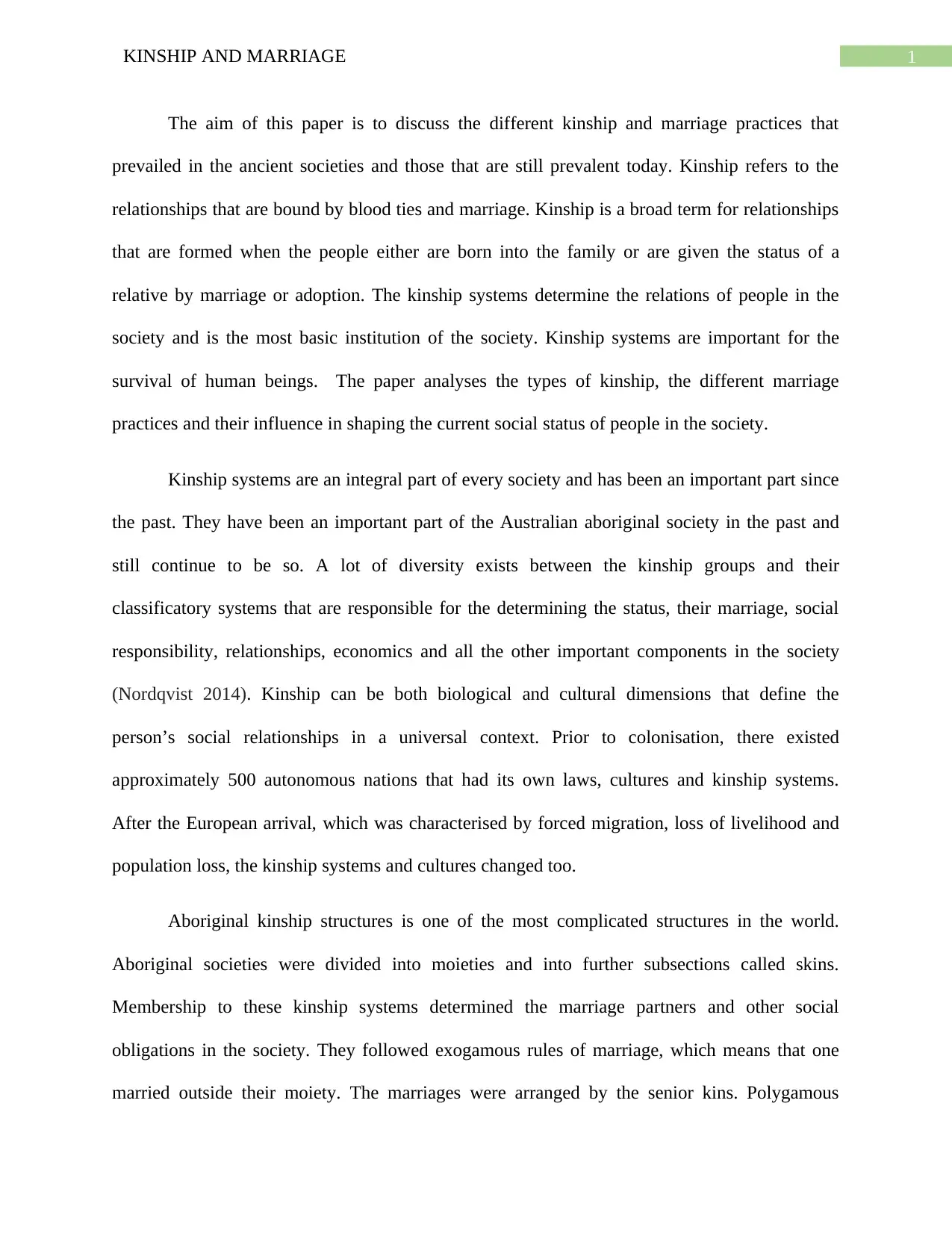
1KINSHIP AND MARRIAGE
The aim of this paper is to discuss the different kinship and marriage practices that
prevailed in the ancient societies and those that are still prevalent today. Kinship refers to the
relationships that are bound by blood ties and marriage. Kinship is a broad term for relationships
that are formed when the people either are born into the family or are given the status of a
relative by marriage or adoption. The kinship systems determine the relations of people in the
society and is the most basic institution of the society. Kinship systems are important for the
survival of human beings. The paper analyses the types of kinship, the different marriage
practices and their influence in shaping the current social status of people in the society.
Kinship systems are an integral part of every society and has been an important part since
the past. They have been an important part of the Australian aboriginal society in the past and
still continue to be so. A lot of diversity exists between the kinship groups and their
classificatory systems that are responsible for the determining the status, their marriage, social
responsibility, relationships, economics and all the other important components in the society
(Nordqvist 2014). Kinship can be both biological and cultural dimensions that define the
person’s social relationships in a universal context. Prior to colonisation, there existed
approximately 500 autonomous nations that had its own laws, cultures and kinship systems.
After the European arrival, which was characterised by forced migration, loss of livelihood and
population loss, the kinship systems and cultures changed too.
Aboriginal kinship structures is one of the most complicated structures in the world.
Aboriginal societies were divided into moieties and into further subsections called skins.
Membership to these kinship systems determined the marriage partners and other social
obligations in the society. They followed exogamous rules of marriage, which means that one
married outside their moiety. The marriages were arranged by the senior kins. Polygamous
The aim of this paper is to discuss the different kinship and marriage practices that
prevailed in the ancient societies and those that are still prevalent today. Kinship refers to the
relationships that are bound by blood ties and marriage. Kinship is a broad term for relationships
that are formed when the people either are born into the family or are given the status of a
relative by marriage or adoption. The kinship systems determine the relations of people in the
society and is the most basic institution of the society. Kinship systems are important for the
survival of human beings. The paper analyses the types of kinship, the different marriage
practices and their influence in shaping the current social status of people in the society.
Kinship systems are an integral part of every society and has been an important part since
the past. They have been an important part of the Australian aboriginal society in the past and
still continue to be so. A lot of diversity exists between the kinship groups and their
classificatory systems that are responsible for the determining the status, their marriage, social
responsibility, relationships, economics and all the other important components in the society
(Nordqvist 2014). Kinship can be both biological and cultural dimensions that define the
person’s social relationships in a universal context. Prior to colonisation, there existed
approximately 500 autonomous nations that had its own laws, cultures and kinship systems.
After the European arrival, which was characterised by forced migration, loss of livelihood and
population loss, the kinship systems and cultures changed too.
Aboriginal kinship structures is one of the most complicated structures in the world.
Aboriginal societies were divided into moieties and into further subsections called skins.
Membership to these kinship systems determined the marriage partners and other social
obligations in the society. They followed exogamous rules of marriage, which means that one
married outside their moiety. The marriages were arranged by the senior kins. Polygamous
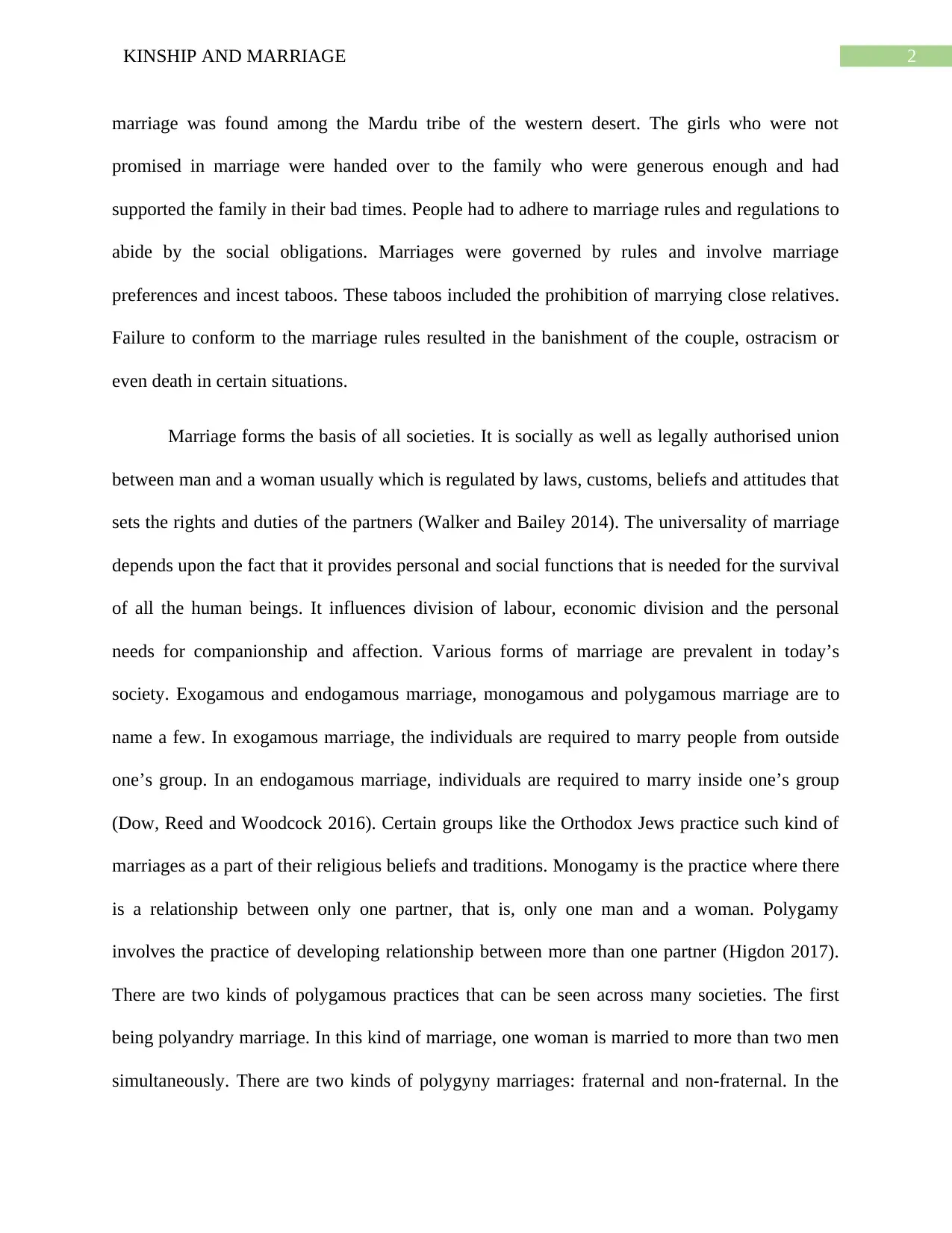
2KINSHIP AND MARRIAGE
marriage was found among the Mardu tribe of the western desert. The girls who were not
promised in marriage were handed over to the family who were generous enough and had
supported the family in their bad times. People had to adhere to marriage rules and regulations to
abide by the social obligations. Marriages were governed by rules and involve marriage
preferences and incest taboos. These taboos included the prohibition of marrying close relatives.
Failure to conform to the marriage rules resulted in the banishment of the couple, ostracism or
even death in certain situations.
Marriage forms the basis of all societies. It is socially as well as legally authorised union
between man and a woman usually which is regulated by laws, customs, beliefs and attitudes that
sets the rights and duties of the partners (Walker and Bailey 2014). The universality of marriage
depends upon the fact that it provides personal and social functions that is needed for the survival
of all the human beings. It influences division of labour, economic division and the personal
needs for companionship and affection. Various forms of marriage are prevalent in today’s
society. Exogamous and endogamous marriage, monogamous and polygamous marriage are to
name a few. In exogamous marriage, the individuals are required to marry people from outside
one’s group. In an endogamous marriage, individuals are required to marry inside one’s group
(Dow, Reed and Woodcock 2016). Certain groups like the Orthodox Jews practice such kind of
marriages as a part of their religious beliefs and traditions. Monogamy is the practice where there
is a relationship between only one partner, that is, only one man and a woman. Polygamy
involves the practice of developing relationship between more than one partner (Higdon 2017).
There are two kinds of polygamous practices that can be seen across many societies. The first
being polyandry marriage. In this kind of marriage, one woman is married to more than two men
simultaneously. There are two kinds of polygyny marriages: fraternal and non-fraternal. In the
marriage was found among the Mardu tribe of the western desert. The girls who were not
promised in marriage were handed over to the family who were generous enough and had
supported the family in their bad times. People had to adhere to marriage rules and regulations to
abide by the social obligations. Marriages were governed by rules and involve marriage
preferences and incest taboos. These taboos included the prohibition of marrying close relatives.
Failure to conform to the marriage rules resulted in the banishment of the couple, ostracism or
even death in certain situations.
Marriage forms the basis of all societies. It is socially as well as legally authorised union
between man and a woman usually which is regulated by laws, customs, beliefs and attitudes that
sets the rights and duties of the partners (Walker and Bailey 2014). The universality of marriage
depends upon the fact that it provides personal and social functions that is needed for the survival
of all the human beings. It influences division of labour, economic division and the personal
needs for companionship and affection. Various forms of marriage are prevalent in today’s
society. Exogamous and endogamous marriage, monogamous and polygamous marriage are to
name a few. In exogamous marriage, the individuals are required to marry people from outside
one’s group. In an endogamous marriage, individuals are required to marry inside one’s group
(Dow, Reed and Woodcock 2016). Certain groups like the Orthodox Jews practice such kind of
marriages as a part of their religious beliefs and traditions. Monogamy is the practice where there
is a relationship between only one partner, that is, only one man and a woman. Polygamy
involves the practice of developing relationship between more than one partner (Higdon 2017).
There are two kinds of polygamous practices that can be seen across many societies. The first
being polyandry marriage. In this kind of marriage, one woman is married to more than two men
simultaneously. There are two kinds of polygyny marriages: fraternal and non-fraternal. In the
⊘ This is a preview!⊘
Do you want full access?
Subscribe today to unlock all pages.

Trusted by 1+ million students worldwide
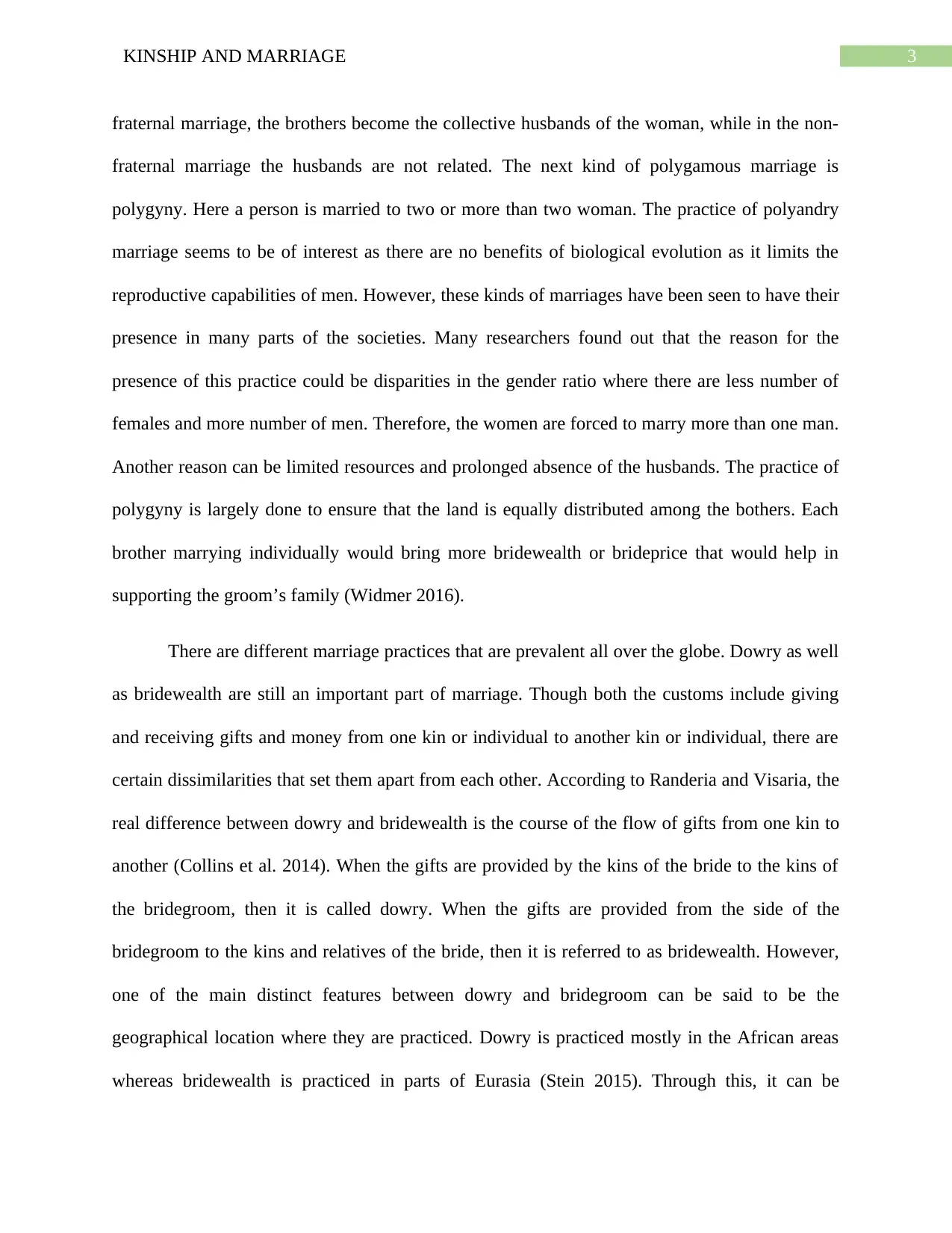
3KINSHIP AND MARRIAGE
fraternal marriage, the brothers become the collective husbands of the woman, while in the non-
fraternal marriage the husbands are not related. The next kind of polygamous marriage is
polygyny. Here a person is married to two or more than two woman. The practice of polyandry
marriage seems to be of interest as there are no benefits of biological evolution as it limits the
reproductive capabilities of men. However, these kinds of marriages have been seen to have their
presence in many parts of the societies. Many researchers found out that the reason for the
presence of this practice could be disparities in the gender ratio where there are less number of
females and more number of men. Therefore, the women are forced to marry more than one man.
Another reason can be limited resources and prolonged absence of the husbands. The practice of
polygyny is largely done to ensure that the land is equally distributed among the bothers. Each
brother marrying individually would bring more bridewealth or brideprice that would help in
supporting the groom’s family (Widmer 2016).
There are different marriage practices that are prevalent all over the globe. Dowry as well
as bridewealth are still an important part of marriage. Though both the customs include giving
and receiving gifts and money from one kin or individual to another kin or individual, there are
certain dissimilarities that set them apart from each other. According to Randeria and Visaria, the
real difference between dowry and bridewealth is the course of the flow of gifts from one kin to
another (Collins et al. 2014). When the gifts are provided by the kins of the bride to the kins of
the bridegroom, then it is called dowry. When the gifts are provided from the side of the
bridegroom to the kins and relatives of the bride, then it is referred to as bridewealth. However,
one of the main distinct features between dowry and bridegroom can be said to be the
geographical location where they are practiced. Dowry is practiced mostly in the African areas
whereas bridewealth is practiced in parts of Eurasia (Stein 2015). Through this, it can be
fraternal marriage, the brothers become the collective husbands of the woman, while in the non-
fraternal marriage the husbands are not related. The next kind of polygamous marriage is
polygyny. Here a person is married to two or more than two woman. The practice of polyandry
marriage seems to be of interest as there are no benefits of biological evolution as it limits the
reproductive capabilities of men. However, these kinds of marriages have been seen to have their
presence in many parts of the societies. Many researchers found out that the reason for the
presence of this practice could be disparities in the gender ratio where there are less number of
females and more number of men. Therefore, the women are forced to marry more than one man.
Another reason can be limited resources and prolonged absence of the husbands. The practice of
polygyny is largely done to ensure that the land is equally distributed among the bothers. Each
brother marrying individually would bring more bridewealth or brideprice that would help in
supporting the groom’s family (Widmer 2016).
There are different marriage practices that are prevalent all over the globe. Dowry as well
as bridewealth are still an important part of marriage. Though both the customs include giving
and receiving gifts and money from one kin or individual to another kin or individual, there are
certain dissimilarities that set them apart from each other. According to Randeria and Visaria, the
real difference between dowry and bridewealth is the course of the flow of gifts from one kin to
another (Collins et al. 2014). When the gifts are provided by the kins of the bride to the kins of
the bridegroom, then it is called dowry. When the gifts are provided from the side of the
bridegroom to the kins and relatives of the bride, then it is referred to as bridewealth. However,
one of the main distinct features between dowry and bridegroom can be said to be the
geographical location where they are practiced. Dowry is practiced mostly in the African areas
whereas bridewealth is practiced in parts of Eurasia (Stein 2015). Through this, it can be
Paraphrase This Document
Need a fresh take? Get an instant paraphrase of this document with our AI Paraphraser
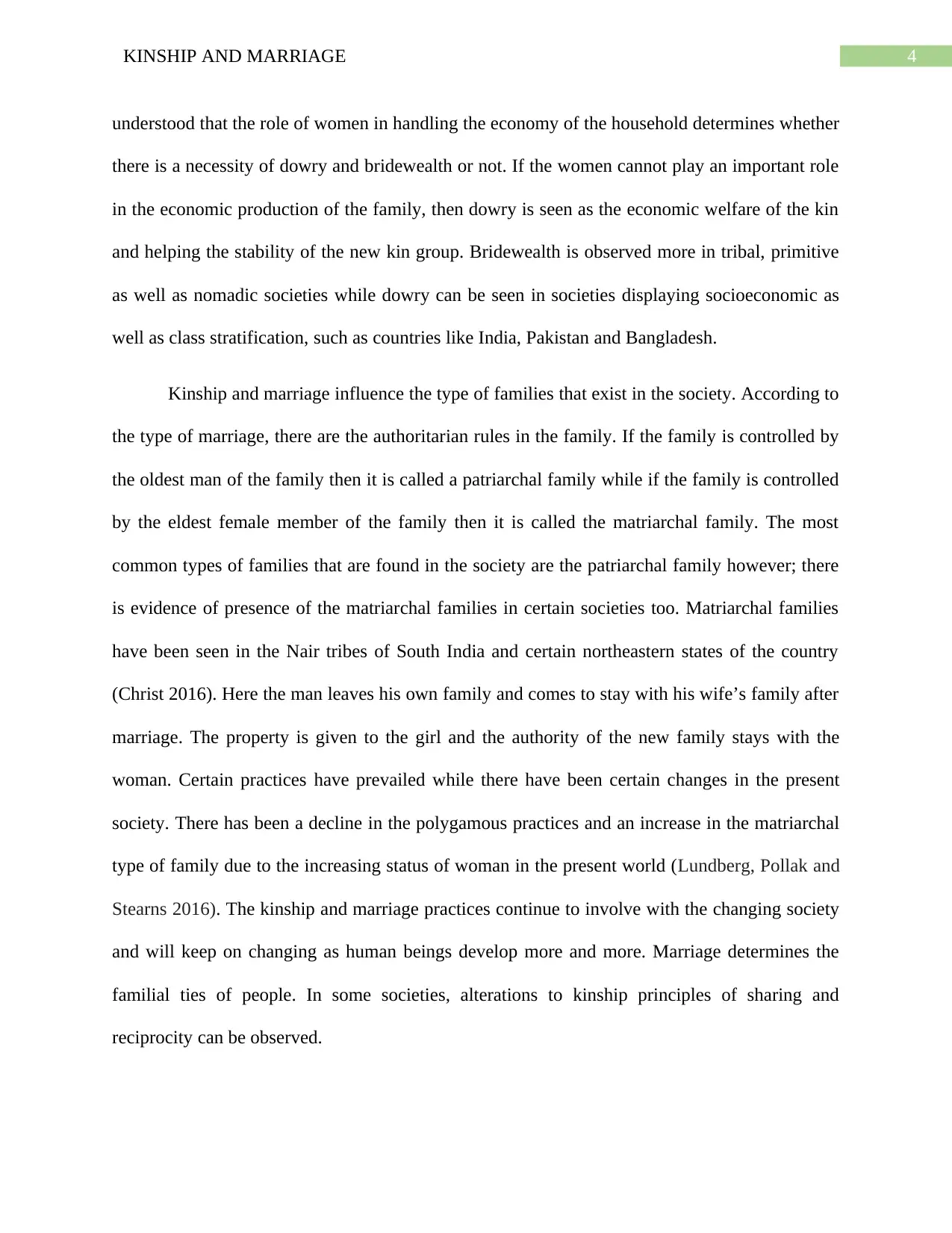
4KINSHIP AND MARRIAGE
understood that the role of women in handling the economy of the household determines whether
there is a necessity of dowry and bridewealth or not. If the women cannot play an important role
in the economic production of the family, then dowry is seen as the economic welfare of the kin
and helping the stability of the new kin group. Bridewealth is observed more in tribal, primitive
as well as nomadic societies while dowry can be seen in societies displaying socioeconomic as
well as class stratification, such as countries like India, Pakistan and Bangladesh.
Kinship and marriage influence the type of families that exist in the society. According to
the type of marriage, there are the authoritarian rules in the family. If the family is controlled by
the oldest man of the family then it is called a patriarchal family while if the family is controlled
by the eldest female member of the family then it is called the matriarchal family. The most
common types of families that are found in the society are the patriarchal family however; there
is evidence of presence of the matriarchal families in certain societies too. Matriarchal families
have been seen in the Nair tribes of South India and certain northeastern states of the country
(Christ 2016). Here the man leaves his own family and comes to stay with his wife’s family after
marriage. The property is given to the girl and the authority of the new family stays with the
woman. Certain practices have prevailed while there have been certain changes in the present
society. There has been a decline in the polygamous practices and an increase in the matriarchal
type of family due to the increasing status of woman in the present world (Lundberg, Pollak and
Stearns 2016). The kinship and marriage practices continue to involve with the changing society
and will keep on changing as human beings develop more and more. Marriage determines the
familial ties of people. In some societies, alterations to kinship principles of sharing and
reciprocity can be observed.
understood that the role of women in handling the economy of the household determines whether
there is a necessity of dowry and bridewealth or not. If the women cannot play an important role
in the economic production of the family, then dowry is seen as the economic welfare of the kin
and helping the stability of the new kin group. Bridewealth is observed more in tribal, primitive
as well as nomadic societies while dowry can be seen in societies displaying socioeconomic as
well as class stratification, such as countries like India, Pakistan and Bangladesh.
Kinship and marriage influence the type of families that exist in the society. According to
the type of marriage, there are the authoritarian rules in the family. If the family is controlled by
the oldest man of the family then it is called a patriarchal family while if the family is controlled
by the eldest female member of the family then it is called the matriarchal family. The most
common types of families that are found in the society are the patriarchal family however; there
is evidence of presence of the matriarchal families in certain societies too. Matriarchal families
have been seen in the Nair tribes of South India and certain northeastern states of the country
(Christ 2016). Here the man leaves his own family and comes to stay with his wife’s family after
marriage. The property is given to the girl and the authority of the new family stays with the
woman. Certain practices have prevailed while there have been certain changes in the present
society. There has been a decline in the polygamous practices and an increase in the matriarchal
type of family due to the increasing status of woman in the present world (Lundberg, Pollak and
Stearns 2016). The kinship and marriage practices continue to involve with the changing society
and will keep on changing as human beings develop more and more. Marriage determines the
familial ties of people. In some societies, alterations to kinship principles of sharing and
reciprocity can be observed.
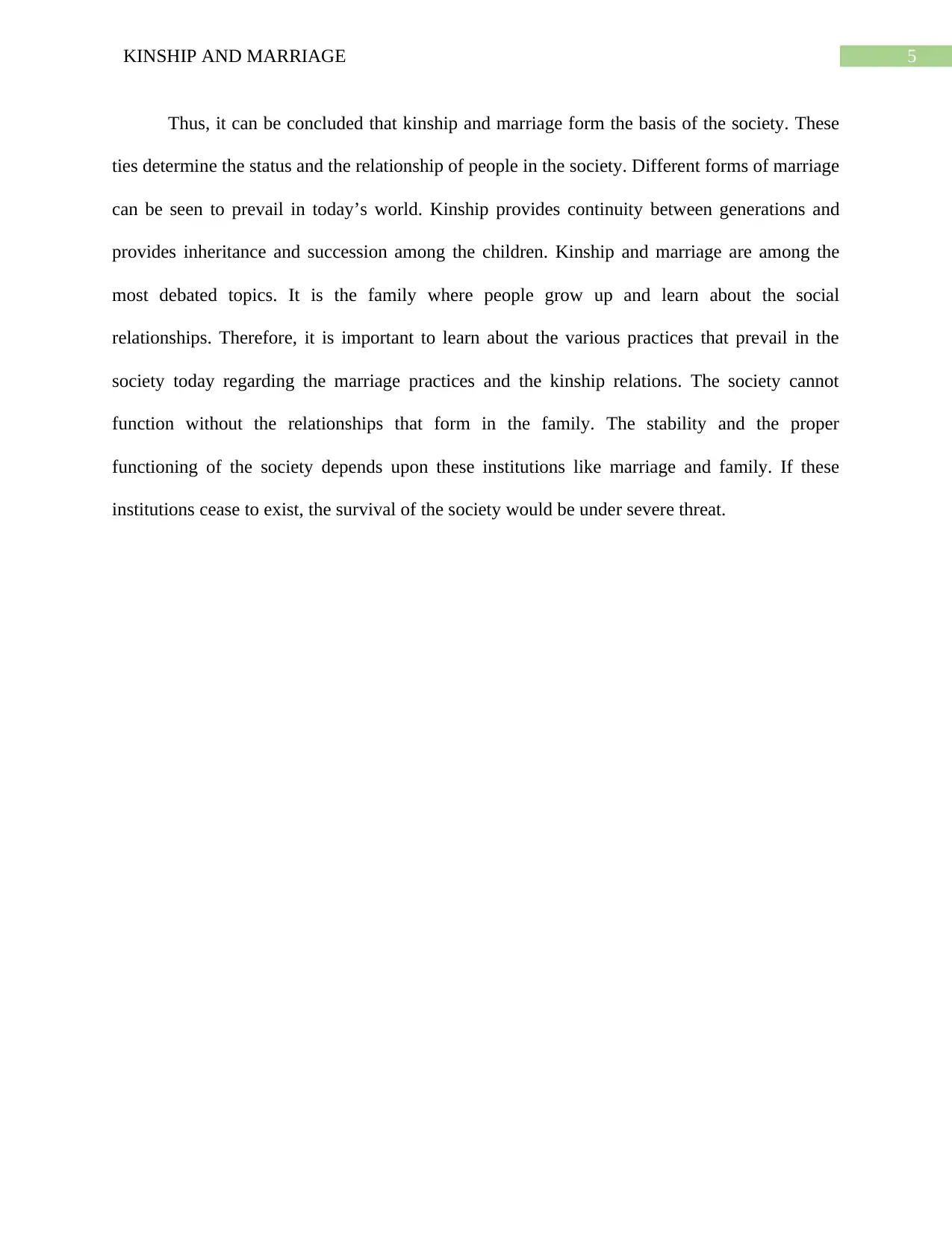
5KINSHIP AND MARRIAGE
Thus, it can be concluded that kinship and marriage form the basis of the society. These
ties determine the status and the relationship of people in the society. Different forms of marriage
can be seen to prevail in today’s world. Kinship provides continuity between generations and
provides inheritance and succession among the children. Kinship and marriage are among the
most debated topics. It is the family where people grow up and learn about the social
relationships. Therefore, it is important to learn about the various practices that prevail in the
society today regarding the marriage practices and the kinship relations. The society cannot
function without the relationships that form in the family. The stability and the proper
functioning of the society depends upon these institutions like marriage and family. If these
institutions cease to exist, the survival of the society would be under severe threat.
Thus, it can be concluded that kinship and marriage form the basis of the society. These
ties determine the status and the relationship of people in the society. Different forms of marriage
can be seen to prevail in today’s world. Kinship provides continuity between generations and
provides inheritance and succession among the children. Kinship and marriage are among the
most debated topics. It is the family where people grow up and learn about the social
relationships. Therefore, it is important to learn about the various practices that prevail in the
society today regarding the marriage practices and the kinship relations. The society cannot
function without the relationships that form in the family. The stability and the proper
functioning of the society depends upon these institutions like marriage and family. If these
institutions cease to exist, the survival of the society would be under severe threat.
⊘ This is a preview!⊘
Do you want full access?
Subscribe today to unlock all pages.

Trusted by 1+ million students worldwide
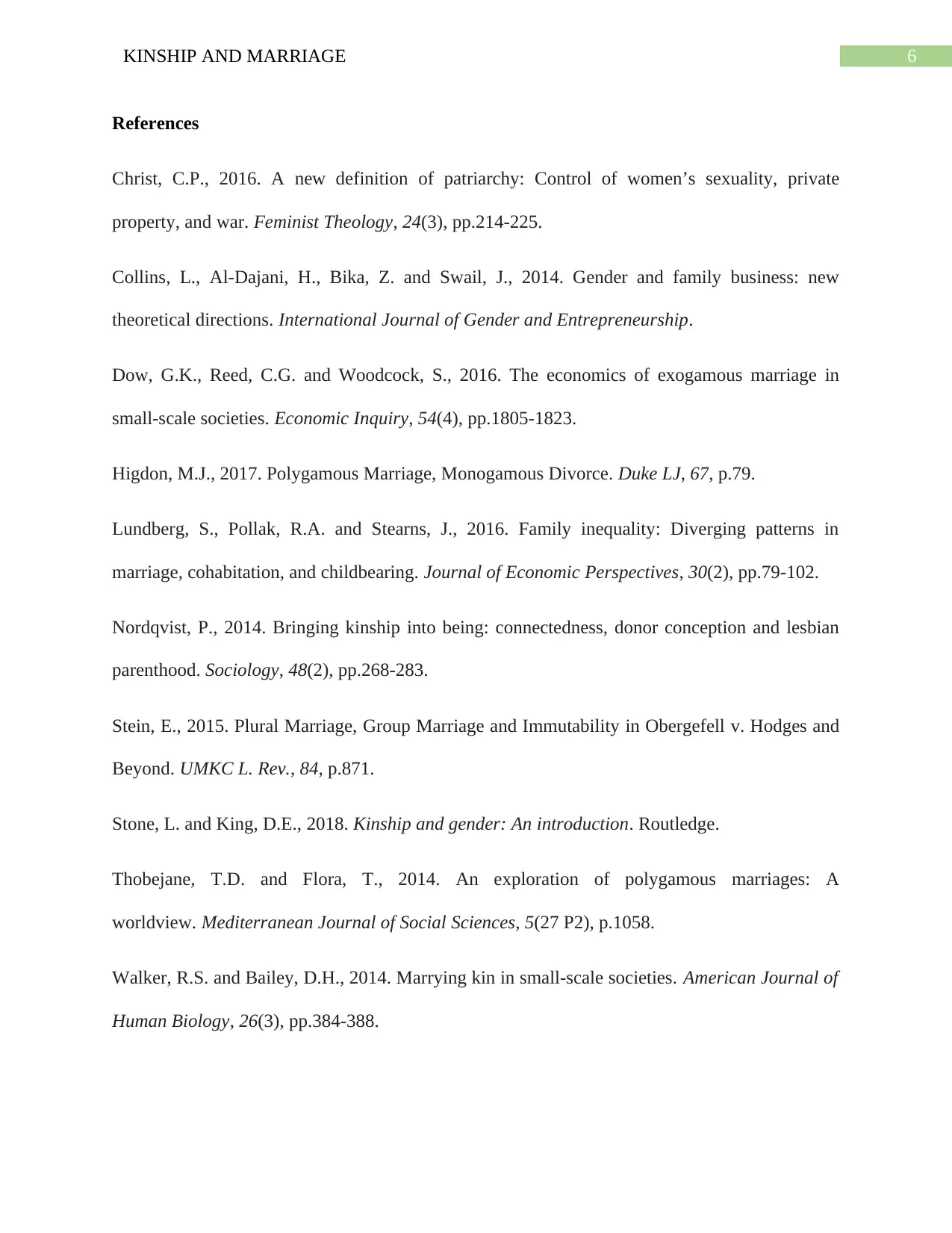
6KINSHIP AND MARRIAGE
References
Christ, C.P., 2016. A new definition of patriarchy: Control of women’s sexuality, private
property, and war. Feminist Theology, 24(3), pp.214-225.
Collins, L., Al-Dajani, H., Bika, Z. and Swail, J., 2014. Gender and family business: new
theoretical directions. International Journal of Gender and Entrepreneurship.
Dow, G.K., Reed, C.G. and Woodcock, S., 2016. The economics of exogamous marriage in
small‐scale societies. Economic Inquiry, 54(4), pp.1805-1823.
Higdon, M.J., 2017. Polygamous Marriage, Monogamous Divorce. Duke LJ, 67, p.79.
Lundberg, S., Pollak, R.A. and Stearns, J., 2016. Family inequality: Diverging patterns in
marriage, cohabitation, and childbearing. Journal of Economic Perspectives, 30(2), pp.79-102.
Nordqvist, P., 2014. Bringing kinship into being: connectedness, donor conception and lesbian
parenthood. Sociology, 48(2), pp.268-283.
Stein, E., 2015. Plural Marriage, Group Marriage and Immutability in Obergefell v. Hodges and
Beyond. UMKC L. Rev., 84, p.871.
Stone, L. and King, D.E., 2018. Kinship and gender: An introduction. Routledge.
Thobejane, T.D. and Flora, T., 2014. An exploration of polygamous marriages: A
worldview. Mediterranean Journal of Social Sciences, 5(27 P2), p.1058.
Walker, R.S. and Bailey, D.H., 2014. Marrying kin in small‐scale societies. American Journal of
Human Biology, 26(3), pp.384-388.
References
Christ, C.P., 2016. A new definition of patriarchy: Control of women’s sexuality, private
property, and war. Feminist Theology, 24(3), pp.214-225.
Collins, L., Al-Dajani, H., Bika, Z. and Swail, J., 2014. Gender and family business: new
theoretical directions. International Journal of Gender and Entrepreneurship.
Dow, G.K., Reed, C.G. and Woodcock, S., 2016. The economics of exogamous marriage in
small‐scale societies. Economic Inquiry, 54(4), pp.1805-1823.
Higdon, M.J., 2017. Polygamous Marriage, Monogamous Divorce. Duke LJ, 67, p.79.
Lundberg, S., Pollak, R.A. and Stearns, J., 2016. Family inequality: Diverging patterns in
marriage, cohabitation, and childbearing. Journal of Economic Perspectives, 30(2), pp.79-102.
Nordqvist, P., 2014. Bringing kinship into being: connectedness, donor conception and lesbian
parenthood. Sociology, 48(2), pp.268-283.
Stein, E., 2015. Plural Marriage, Group Marriage and Immutability in Obergefell v. Hodges and
Beyond. UMKC L. Rev., 84, p.871.
Stone, L. and King, D.E., 2018. Kinship and gender: An introduction. Routledge.
Thobejane, T.D. and Flora, T., 2014. An exploration of polygamous marriages: A
worldview. Mediterranean Journal of Social Sciences, 5(27 P2), p.1058.
Walker, R.S. and Bailey, D.H., 2014. Marrying kin in small‐scale societies. American Journal of
Human Biology, 26(3), pp.384-388.
Paraphrase This Document
Need a fresh take? Get an instant paraphrase of this document with our AI Paraphraser

7KINSHIP AND MARRIAGE
Widmer, E.D., 2016. Family configurations: A structural approach to family diversity.
Routledge.
Widmer, E.D., 2016. Family configurations: A structural approach to family diversity.
Routledge.
1 out of 8
Related Documents
Your All-in-One AI-Powered Toolkit for Academic Success.
+13062052269
info@desklib.com
Available 24*7 on WhatsApp / Email
![[object Object]](/_next/static/media/star-bottom.7253800d.svg)
Unlock your academic potential
Copyright © 2020–2025 A2Z Services. All Rights Reserved. Developed and managed by ZUCOL.





